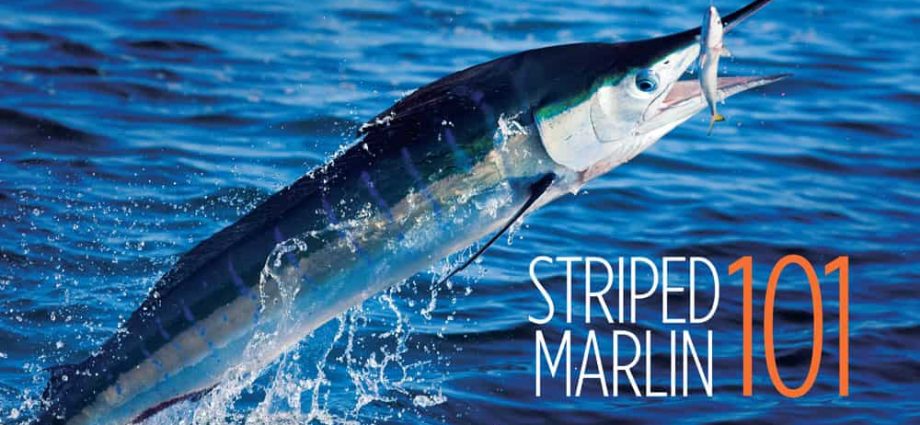Contents
Striped marlin is a fish of the sailboat, marlin or spearfish family. According to the main external features, this fish is similar to other main species of the family. First of all, it is a powerful, pursuing body and the presence of a spear-shaped process on the upper jaw. Many marlins are sometimes confused with the swordfish, which is distinguished by its body shape and larger nose “spear”, which is flattened in cross-section, in contrast to the round marlins. In striped marlin, the body is slightly flattened laterally. The anterior dorsal fin begins at the base of the head, its anterior rigid rays have a height comparable to the width of the body. The posterior dorsal fin, located closer to the tail, repeats the shape of the anterior one, but is much smaller. The ventral and pectoral fins have grooves on the body where they fold during moments of rapid attacks. The powerful caudal peduncle has keels and ends in a large sickle-shaped fin. The body of all marlins is covered with oblong small scales, which are completely immersed under the skin. Researchers consider striped marlin to be very swift predators, capable of reaching speeds of over 75 km/h. Despite the fact that their maximum sizes are much less than the main types of marlin. Striped marlin grow up to 190 kg with a body length of 4.2 m. Among amateur fishermen, striped marlin is considered a very worthy and desirable trophy despite its relatively small size among fish of the sailfish family, because this fish has an exceptional temperament. The most notable external characteristic is the coloration. The back of the fish has a dark blue color, the sides are silvery with a blue tint, while numerous transverse blue stripes run along the entire body. The fins have numerous iridescent spots. The behavior and characteristics of living conditions are similar to other marlins. Hunts alone or in small groups, lives in the upper layers of water at some distance from the coastal zone. Basically, it hunts schooling fish species, as well as squid and other species that live in the pelargic zone of the seas.
Ways to catch striped marlin
Marlin fishing is a kind of brand. For many anglers, catching this fish becomes a dream of a lifetime. The main way of amateur fishing is trolling. Various tournaments and festivals are held for catching trophy marlin. An entire industry in sea fishing specializes in this. However, there are amateurs who are eager to catch marlin on spinning and fly fishing. Do not forget that catching large individuals requires not only great experience, but also caution. Fighting large specimens can sometimes become a dangerous occupation.
Catching striped marlin on trolling
Striped marlin, along with other species of the family, are considered the most desirable opponents in sea fishing due to their size and temperament. After hooking, this species behaves especially dynamically, creating the most memorable fishing experience. To catch them, you will need the most serious fishing tackle. Sea trolling is a method of fishing using a moving motor vehicle such as a boat or boat. For fishing in the ocean and sea open spaces, specialized vessels equipped with numerous devices are used. In the case of marlin, these are, as a rule, large motor yachts and boats. This is due not only to the size of possible trophies, but also to the conditions of fishing. The main elements of the ship’s equipment are rod holders, in addition, boats are equipped with chairs for playing fish, a table for making baits, powerful echo sounders and more. Specialized rods are also used, made of fiberglass and other polymers with special fittings. Coils are used multiplier, maximum capacity. The device of trolling reels is subject to the main idea of such gear – strength. A monofilament with a thickness of up to 4 mm or more is measured in kilometers during such fishing. There are quite a lot of auxiliary devices that are used depending on the fishing conditions: for deepening the equipment, for placing baits in the fishing area, for attaching bait, and so on, including numerous items of equipment. Trolling, especially when hunting for sea giants, is a group type of fishing. As a rule, several rods are used. In the case of a bite, the coherence of the team is important for a successful capture. Before the trip, it is advisable to find out the rules of fishing in the region. In most cases, fishing is carried out by professional guides who are fully responsible for the event. It is worth noting that the search for a trophy at sea or in the ocean may be associated with many hours of waiting for a bite, sometimes unsuccessful.
Baits
For catching marlin, various baits are used: both natural and artificial. If natural lures are used, experienced guides make baits using special rigs. For this, carcasses of flying fish, mackerel, mackerel and so on are used. Sometimes even living creatures. Wobblers, various surface imitations of marlin food, including silicone ones, are artificial baits.
Places of fishing and habitat
The area of distribution of striped marlin is located in the waters of the seas of the Indo-Pacific region. Like other marlins, they are heat-loving fish and prefer tropical and subtropical latitudes. Within these natural zones, marlin make seasonal migrations in search of food objects, as well as optimal water temperatures in the surface water layer.
Spawning
Sexual maturity usually occurs in fish at the age of three. Spawning takes place all year round and depends on the region of habitat. The fecundity of fish is quite high, but the survival rate of larvae is low. Young fish develop and gain weight very quickly.










